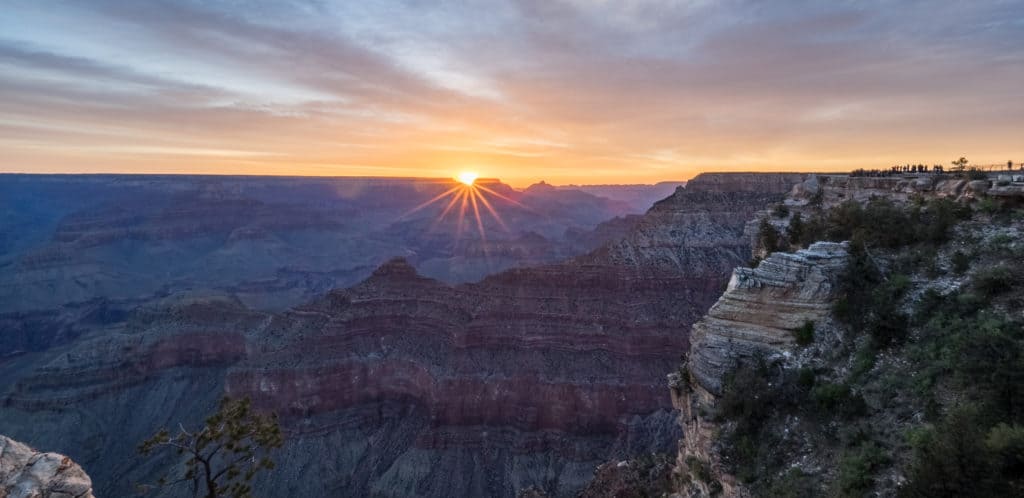One of the world’s truly spectacular wonders, the Grand Canyon has been a favorite vacation destination for generations. Since 1919, the National Park Service has organized and preserved the Grand Canyon as part of Grand Canyon National Park, ensuring that this beloved natural landscape remains a memorable attraction for people of all ages.

Today, most visitors to the Grand Canyon head to its stunning South Rim. There you will find nearly two-dozen different possible viewpoints, all of which are open year-round. There is something for everyone spread across this remarkable array of stopping points. For those who want to experience the Grand Canyon at its most vertical, head to The Abyss, where you can look straight down some 3,000 feet. Lovers of gorgeous sunsets cannot afford to miss Hopi Point, long considered the best place along the South Rim to watch the sun go down. Those visitors that want to find a great mix of food and drink options right alongside spectacular views should consider Desert View Point, found right at the eastern edge of the Park. Most people will want to begin their Grand Canyon adventures at Mather Point, which offers superb sightlines of the Canyon only steps from the Grand Canyon Visitor Center and a number of additional amenities and tourist attractions.
Many visitors also enjoy making the trip to the North Rim of the Grand Canyon. Much less crowded than the South Rim, the North Rim closes during the winter months—though hikers and cross-country skiers may apply for backcountry permits to enter the region during the winter season. At heights of over 8,000 feet, the North Rim rises some 1,000 feet higher than the South Rim, and is much less accessible. However, those who do make the journey to the North Rim will love its selection of hiking trails—which include everything from the short, half-mile long Bright Angel Point Trail to the 24-mile round-trip Arizona Trail—and amenities such as the North Rim Visitor and the Grand Canyon Lodge.
South Rim View Points
The Abyss
Providing visitors access to stunning views of Grand Canyon National Park that at times measure 3,000 feet straight down to the floor of the canyon, The Abyss more than lives up to its memorable name. Its remarkable vantagepoints and appealing trails are perfect for avid photographers and active hikers alike.
Desert View Point
Located right at the eastern entrance to Grand Canyon National Park, Desert View Point is a perfect introduction to the South Rim of the Grand Canyon. Here you will find spectacular views looking west out over the Canyon, as well as plentiful amenities and the famous man-made observation tower, the Desert View Watchtower.
Grandview Point
Grandview Point is home to a lovely mix of local wildlife, stunning views, and memorable hiking. Long a favorite spot for visitors to the South Rim, it provides access to the acclaimed Grandview Trail.
Hopi Point
Hopi Point is the most popular place along the South Rim from which to watch the sunset. It offers unobstructed views of the western portions of the Grand Canyon, as well as provides beautiful sightlines of the various rapids running below.
Lipan Point
Even though it is known as one of the best spots to catch the sunset along the entire South Rim, Lipan Point’s distance from such amenities as the Grand Canyon Visitor Center makes it a less-crowded stop along Desert View Drive. This hidden gem is well worth the time and effort.
Maricopa Point
The view from Maricopa Point is largely unobstructed to the north, east, and west, making it a terrific starting place for those setting out to explore all the wonders available along the South Rim of the Grand Canyon.
Mather Point
Located right near the South Entrance Station of Grand Canyon National Park, Mather Point is only a pleasant ten-minute walk from the Grand Canyon Visitor Center. With its breathtaking views—found not far from ample parking options—Mather Point is a popular place for visitors to begin their South Rim adventures.
Mohave Point
Mohave Point offers tremendous views of surrounding natural wonders such as The Abyss, Hopi Point, and the Colorado River. It is also a terrific spot from which to watch the sun rise or set over the Grand Canyon.
Moran Point
Due to the particularly panoramic views available from its breathtaking heights, Moran Point is one of Grand Canyon National Park’s most popular stops along the lovely Desert Rim Drive. Photographers and hikers alike will find much to love at this remarkable location.
Navajo Point
Located just to the west of Desert View, right inside the eastern entrance to the South Rim portion of Grand Canyon National Park, Navajo Point features an array of stunning views in a number of directions and serves as an outstanding introduction to the many wonders of the region.
Pima Point
Pima Point offers some of the most attractive views found along the South Rim, with an array of memorable vistas available in multiple directions. It is a must-stop for photography buffs.
Powell Point
The stunning overlook at Powell Point offers remarkable views of the eastern segments of the Grand Canyon. It is also home to a memorial honoring the life and work of John Wesley Powell, for whom the stop is named.
Shoshone Point
Shoshone Point is a hidden gem found along the East Rim of the Grand Canyon, affording visitors quiet, peaceful views of a tremendous expanse of the canyon. Certain National Park facilities at Shoshone Point may also be reserved for private events.
Yaki Point
One of the most popular stops along the East Rim of the Grand Canyon, Yaki Point is a great spot to watch the sun rise or set. Its unique position in Grand Canyon National Park makes it a favorite destination for photography buffs and/or hiking aficionados.
Yavapai Point
Visitors to Yavapai Point will enjoy its wide-ranging views of a number of the Grand Canyon’s most famous landmarks, as well as its proximity to several appealing food, drink, and souvenir options.